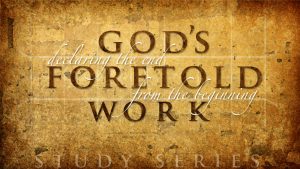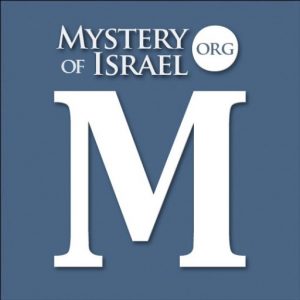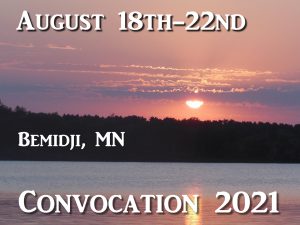Is the Day of the Lord visible in the Pentateuch [aka The Torah: Genesis, Exodus, Leviticus, Numbers, Deuteronomy]? I think this is beyond what one would call “an interesting topic”
The Pentateuch (first five books) is the foundational seed bed for the eschatology of the covenant, which will be developed and detailed by the later prophets around the concept of the day of the Lord. While the day of the Lord is not explicit in the Pentateuch, it is certainly implicit. It is anticipated and required by what we might call, ‘the dilemma of the covenant’. The conditional structure of the covenant in the Pentateuch sets up the necessity of a supernatural divine intervention of apocalyptic judgment and transforming revelation. Otherwise, abiding Jewish inheritance of the Land would be a hopeless prospect.
The prophets saw the coming day of the Lord as the transitional point of division between the ages. It would accomplish the final resolution to Israel’s long exile and suffering under the curses of the broken covenant (see chapters Lev 26; Deut 28 through 32). It would mark the end of gentile supremacy (i.e., “the times of the gentiles”; Ezek 30:3 with Lk 21:24), with the restoration of the kingdom to Israel” (Dan 2:44; Zech 1:17; 2:12; Acts 1:6; 3:21). It would secure the regeneration and final return of the penitent survivors of Jacob’s trouble (Isa 59:21; 66:8; Jer 30:7; Ezek 39:22, 28-29; Dan 12:1; Zech 12:10; Mt 23:39; Ro 11:25-26). Through terrible judgments (Ezek 20:33-34, 37), in combination with amazing grace and mercy, Jewish unbelief will be conquered once and for all, as a hopelessly disobedient people are “born in one day” (Isa 66:8; Zech 3:9). Moses prophesied that this transformation would come when Israel is “in tribulation, even in the latter days” (Deut 4:30-31).
The revelation of a coming day of the Lord solves the dilemma created by the tension that exists between the unconditional oath made to the Fathers and the subsequent covenant conditions that could only be fulfilled by the power of the Spirit. How else could a people always prone to backslide ever continue in the Land forever? How else could a little agrarian nation surrounded by aggressive super powers lie down in safety?
The eschatology of the covenant is implicit in many of the statements of Moses. For example, at the threshold of entering the land, Moses declares his pessimism concerning Israel’s ability to continue long in the Land. “And it shall come to pass, when many evils and troubles are befallen them, that this song shall testify against them as a witness; for it shall not be forgotten out of the mouths of their seed: for I know their imagination which they go about, even now, before I have brought them into the land which I swore to give them (Deut 31:21). For I know that after my death ye will utterly corrupt yourselves, and turn aside from the way which I have commanded you; and evil will befall you in the latter days” (Deut 31:29).
Moses gives the principal reason why the nation’s tenure in the Land would not be long. “Yet the Lord hath not given you an heart to perceive, and eyes to see, and ears to hear, unto this day. (Deut 29:4). This damning condition would persist until the eschatological gift of the new heart promised in Deut 30:6. Apart from regeneration, the intractable condition of the natural heart would continue to doom the nation to the perpetual curse of judgment and exile. But Deut 30:1-2, 3-4, 5-6 anticipates the coming in of a New Covenant. The New Covenant gives the righteousness that the Law demands but could not give. That is the task of the New Covenant (“I will put,” Jer 31:33; 32:40; Ezek 11:19; 36:27).
Moses prophetically anticipates the New Covenant when he says, “And the Lord thy God will bring thee into the land which thy fathers possessed, and thou shalt possess it; and he will do thee good, and multiply thee above thy fathers. And the Lord thy God will circumcise thine heart, and the heart of thy seed, to love the Lord thy God with all thine heart, and with all thy soul, that you may live” (Deut 30:5-6).
This is as much an eschatological promise of national resurrection as anything in Ezek 37 or elsewhere in the prophets. This is the language of divine enablement through the miracle of regeneration. In order to see how Jeremiah would have conceived of the New Covenant, we need to understand that the covenant envisioned an actual Jewish inheritance of the Land that would be enduring and without further threat of the curse. Final security in the Land was an inalienable feature of the ‘everlasting covenant of peace’ (Gen 17:7-8; Lev 26:6; Ps 105:10-11; Isa 54:10; 61:8-9; Jer 23:6; 32:37, 40-41; Ezek 34:25, 28; 36:27-28; 37:26; 39:28-29; Zeph 3:13, 20). This is why the prophets envision a nation that is entirely righteous to the last person.
In order for the covenant to be fulfilled in its full scope, it is not enough that only a remnant receive a new heart and a new spirit (Ezek 11:19; 36:26), because the presence of a godly remnant was never sufficient to keep the nation from backsliding and going again into exile, so a mere remnant existing within a mostly apostate nation could never be sufficient to make the promise sure of everlasting inheritance.
The saints of the OT were not strangers to the law written in the heart (Ps 37:31; 40:8; 51:10; Isa 51:7), and the indwelling and infilling of the Holy Spirit (Gen 41:38; Ex 28:3; 31:3: 35:21; Num 14:24; 27:18; Deut 34:9; Ps 51:10-12; Neh 9:30; Isa 63:11; Dan 4:8; 5:11, 14; Mic 3:8; 1Pet 1:11), but they also knew that the presence of a godly remnant was insufficient to save the nation from exile (e.g., Jeremiah, Ezekiel, Daniel). That is why they envisioned an ‘everlasting righteousness’ (Jer 32:40; Dan 9:24) that would extend to all the nation (Isa 4:3; 60:21; Jer 31:34; Ezek 39:22, 28-29), and to every child born to them thereafter (Isa 44:3; 45:25; 54:13; 59:21; 61:9; 65:9, 23; 66:22, etc.).
“From that day and forward” (Ezek 39:22), not one of the elect seed of Israel will ever fail of this everlasting covenant of grace (Ps 89:30-31, 32-33, 34; Isa 59:21; Jer 31:34; 32:40). In this way, the inheritance of the Land will be sure to all future generations of the Jewish people until the end of the millennium.
At the day of the Lord, the revelation on which the church is built (Mt 16:17-18) will shine through to the penitent remnant when the Deliverer comes out of Zion (Isa 59:16-17, 18-19, 20-21; 63:4-5; Zech 12:10; Ro 11:25-26, 27). The day of the Lord arrives with the end of the unequaled tribulation (Isa 66:8; Mic 5:3; Jer 30:7; Dan 12:1; Mt 24:21, 29).
We conclude that the New Covenant is essentially the covenant of regeneration established in the Godhead before the foundation of the world (Heb 13:20; Rev 13:8), but here in Jeremiah, as in the other prophets that speak of the “everlasting covenant,” the emphasis is on that time when there would be no more a mere remnant dwelling in the midst of an apostate nation, because the covenant promises that “all Israel shall be saved.” This means that from the day of the Lord and forward (Ezek 29:22), every Jewish survivor of the tribulation would be holy, able now to inherit the Land forever. This is manifestly the Old Testament background behind Paul’s use of the phrase, “And thus all Israel shall be saved” (Ro 11:26).
Because it is God’s own righteousness, and nothing of their own, not one among them will ever again depart from the holy fear that God will put in their heart by the regenerating power of His Spirit (Isa 45:17; 59:21; Jer 32:40). Such miraculous uniformity of Jewish salvation will be an astonishment and a witness to the nations of God’s ability to accomplish His impossible mission to plant Israel permanently in their own Land, without fear of further judgment or expulsion (2Sam 7:10; Jer 24:6-7; 31:28; 32:41; Amos 9:15; Lk 1:73-75).
God will not relent concerning the people of His special election lest the Word of His promise appear to be defeated by Jewish unbelief (compare Num 14:15-21; Deut 32:26-27; Ezek 36:22-23, 32-36; 39:27; Ro 9:16). It is this historic enmity that God is determined to overcome, ere the age can end. “For God is able to graft them in” (Ro 11:23).
An examination of the context will show that the New Covenant is not established with Israel as a nation until AFTER the ‘time of Jacob’s trouble’ (Jeremiah, chapters 30 – 31). [Note: Jacob’s trouble is the great tribulation (or Zion’s travail) that ends with the day of the Lord (compare Isa 13:6-8, 10; 66:8; Mic 5:3; Jer 30:7; Dan 12:1; Joel 2:31; 3:14-15; with Mt 24:29; Acts 2:20; Rev 16:14-15). The tribulation designs to remove the pride and power of self-sufficiency that hinders the faith of the prodigal nation (Deut 32:36; Ezek 20:3-34, 37; Dan 12: 7).]
Moses further shows that the face of God must remain hidden from the larger nation (Deut 31:17-18; 32:20; Isa 8:17), until “that day” when the Spirit will be poured out upon the whole house of Israel (Ezek 39:22, 28-29 with Zech 12:10).
What then could make the promise of enduring inheritance permanent and secure? Only the everlasting righteousness of Christ, as “the Lord our righteousness” (Isa 54:17; Jer 23:5-6). His righteousness, in contrast to all human righteousness, is alone sufficient to meet all the demands of the covenant, and so preserve the nation in the Land forever, as well as give every believer the full assurance of final glory. This is the righteousness that is revealed in the gospel (Ro 1:17). It is the everlasting righteousness that belongs only to God (Mk 10:18; Ro 7:18; Ro 10:3; Phil 3:9).
The revelation of the day of the Lord, however, solves only part of the dilemma of the covenant. It does not explain the basis by which eternal life and the gift of the Spirit can be lawfully given to the believer. This would only come to light with the glorious revelation of the mystery of the gospel. The atonement is at the heart of the mystery of Christ’s twofold coming to Israel. This was unknown in other ages (Ro 16:25-26; Eph 3:5; 6:19; Col 1:26; 1Pet 1:11). “Which none of the princes of this world knew, for had they known it, they would not have crucified the Lord of glory (1Cor 2:7-8).
The atonement is the basis of all salvation in both testaments. Contrary to anything that anyone expected, Messiah would come twice, a first time to accomplish the atonement, and a second time “immediately after the tribulation of those days” (Mt 24:29). Though entirely foretold (Isa 53:8; Isa 66:7; Mic 5:1, 3-4; Dan 9:26; Acts 26:22; Ro 16:25-26; 1Pet 1:11), the ‘hidden wisdom’ of a crucified and risen, twice coming Messiah and Lord, would remain concealed within the prophetic scriptures (Ro 16:26) until the appointed time of revelation.
So the early stages of redemptive history begins in a conflict between an unconditional election and promise (God swears by Himself alone while Abraham is in a deep sleep; Gen 15:12) and the addition of conditions that require a righteousness too high for man, such that only God could provide. The means by which God would provide this righteousness was only dimly seen in other ages. Full light concerning the nature and basis of this righteousness would not come until after the mystery of the gospel was revealed to the apostles and prophets of the early church after the Lord’s resurrection (Mk 8:30; 9:9; Lk 24:21; Acts 1:6 with Acts 3:21; Eph 3:5).
However dimly understood in other ages, no one was ever justified by any other righteousness than the righteousness of God in Christ, since no other righteousness was ever acceptable in any age or dispensation. Therefore, since it is clear that Old Testament saints were most certainly alive to God by the Spirit, we conclude that God imputed the righteousness of Christ to those that were regenerate by faith before the fuller revelation of “the mystery of the gospel” (Eph 6:19).
The prophets understood the necessity of regeneration, which they spoke of by such expressions as “circumcision of the heart, new spirit, law written in the heart,” etc. They also understood that the regeneration of only a few could never meet the conditions required for the promise of security in the Land to be sure and lasting. This is the conflict that is created by extravagant promises that were made to depend on the fulfillment of conditions that are too high for human ability. The prophets saw these humanly impossible conditions all fully met by the apocalyptic in-breaking of God in the day of the Lord. But the revelation of a day that would regenerate the nation and break the power of the gentiles is only part of the solution to the dilemma of the covenant, because there can be no new birth without an atonement.
The ultimate solution, therefore, would await the first century revelation of the mystery of the gospel (Ro 16:25-26; Eph 6:19). The mystery of a partial present fulfillment (the ‘already’) and a deferred day of the Lord (the ‘not yet’), built around two comings of the Messiah to Israel, reveals how the New Covenant is received first by the church, with a view of making Israel jealous (Ro 11:11, 14, 31) and finally by the penitent survivors of Israel at the end of the tribulation.
So the Pentateuch sets up the background for the covenant dilemma that gave rise to the revelation of the day of the Lord, which prepared the way for the more ultimate and final revelation of Christ’s atonement in the context of His twofold appearing to Israel.
So the mystery reveals two stages of covenant fulfillment. The church sees clearly the first stage that was not known in other ages (Ro 16:25-26; 1Pet 1:11), but to its great loss, it has all but lost sight of the second stage that the prophets saw so clearly.
Lord, restore the original context of the mystery, by which your greater glory is made to shine more brightly.
Reggie




